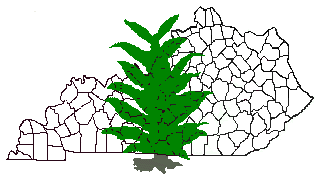
July 25, 1999, KY Dam Village Convention Center, Gilbertsville, KY
See the details on the Pesticide Applicator Training Web Site http://www.uky.edu/Agriculture/PAT/welcome.htm

A BLUE MOLD ADVISORY REMAINS IN PLACE STATEWIDE, with WATCHES/WARNINGS for large areas of the Commonwealth. Blue mold is becoming more uniformly distributed in communities that have reported activity for several weeks, and many new communities reported their first activity during the past five days. In counties with active blue mold, most County Extension Agents were reporting only very light activity with occasional hot spots through last week. However, some are now reporting moderate to very strong activity in the hot spots, with rapidly increasing activity in fields of lush tobacco, especially in fields that received large amounts of water over the past two weeks. Massive disease levels are present in some float beds and greenhouses, mostly in abandoned transplant operations. Even in counties with confirmed cases, agents are indicating that most fields are still without visible levels of activity. Susceptibility of tobacco leaf tissues are highly variable from field to field. Especially vulnerable are fields of very rapidly growing tobacco with wet soil, where the canopy has closed (either between plants or between rows) located in regions that experienced extensive cloud cover and nightly fogs last week. Prevailing winds have been sending spores mainly north and east from sites of active blue mold during the past 10 days.
The spore volume has been increasing rapidly during the past five days in some communities, but it is highly variable from community to community. The hot weather being experienced has increased symptom development, but it has significantly slowed the potential for new blue mold development in most areas. High temperatures at night have had the most impact on slowing disease development, because in fields with wet soil and closed canopy, evaporative cooling has prevented temperatures from going high enough to stop the disease. In some test plot sites, temperatures on July 4 were in the mid 90's outside the tobacco field, while at 18 inches within the row, temperatures did not exceed 84 F during the daytime, while at night, they did not drop below 73F. In contrast, in fields of young tobacco with open canopy, the temperatures recorded in the row and outside the field were about equal, which should have been high enough to slow development.
The sudden emergence of damaging levels of disease over a large area of the state is still unlikely at this time, but very strong activity in individual fields is possible, especially where "hot spots" are already established, lush growth is developing, the canopy has closed shading lower leaves, and the soil is wet and/or fog is developing. Hazy conditions will help protect spores from sunlight, and closing canopy will provide enough cool places to allow continued development, so the disease will continue to increase, greatly increasing the spore load available for the future. Protective fungicide sprays are needed in communities under watches or warnings. Blue mold could "explode" in some communities where it is remaining active, with a return to cooler temperatures, with moisture as fog or light rain.
Status reports by Extension Area are as follows.
Foliar fungicide sprays, applied at 5-7 day intervals, are recommended for communities under a watch or warning and all irrigated crops. Follow label directions as to spray volume, fungicide rate, and nozzle arrangements. Acrobat MZ will be the more effective fungicide. A major effort should be made to destroy ALL transplants not being specifically maintained (with fungicides) for late plantings, lest they become sites to harbor buildup of blue mold. Such sites are driving disease development in most communities reporting strong disease.
![]() For current blue mold information, go to the Ky Blue Mold Warning System at:
For current blue mold information, go to the Ky Blue Mold Warning System at:
http://
www.uky.edu/Agriculture/kpn/kyblue/kyblue.htm

As was forecasted earlier, black shank is very active and causing much damage. Several senior County Extension Agents are reporting the strongest activity they have ever observed at this stage of the crop. Especially of concern is the widespread development on farms without a history of the disease and the development in a complex with soreshin and Fusarium (wilt and basal stem rot).
We have a major survey underway to check for fungicide resistance and to determine strains/race of the pathogen involved. However, meaningful results will not likely be available from that study until this winter. The current priority is to collect isolates that can be studied later in the season. I urge agents to continue to send samples into the lab so we can be sure some isolates from your county are included.
We are finding strong evidence to link spread in some cases to infested transplants. But, by this stage of the season, secondary spread has occurred and it is much more difficult to sort out the initial source of infestation. I recently visited a "first-time black shank farm in which the grower had several fields of tobacco, some with newly developed disease and some without symptoms. All the fields with development had come from one greenhouse, while all those without symptoms were from another transplant supplier, both local plant suppliers.
When the disease is introduced on transplants, it usually develops initially with pattern of scattered plants distributed about the field. However, I recently visited a case in which the development was mainly distributed as scattered plants within particular rows about the field. This indicates that some trays were infested while others were not. However, other transplant diseases may have also been playing a role.
Maintain fungicide programs (preplant, cultivation, and layby) on fields with a history of black shank. At this stage, for fields with newly developed disease, about all that can be done is minimize further spread (be careful with equipment and irrigation) and to use the rescue treatments (soil directed) with Ridomil Gold or Ultra Flourish. Some preliminary tests results are in with Ultra Flourish, indicating equal performance with Ridomil Gold.
 Japanese beetles are not a significant tobacco pest but will feed some on the crop. Clusters of beetles may accumulate in the bud area and feed but generally this occurs on a few scattered plants, often along border rows. Individual beetles do not eat much but a handful of them on a plant can make it look pretty rough, even damaging the bud.
Japanese beetles are not a significant tobacco pest but will feed some on the crop. Clusters of beetles may accumulate in the bud area and feed but generally this occurs on a few scattered plants, often along border rows. Individual beetles do not eat much but a handful of them on a plant can make it look pretty rough, even damaging the bud.
Damage is rarely intense enough across a field to justify the cost of an insecticide application. In determining whether or not to treat, consider the number of plants infested and whether or not bud damage is occurring. If 5% or more of the buds are being eaten by this insect and beetle flight is continuing into the field, then treatment might pay off. If beetles are confined to specific areas along fence rows, then spot treatment may be justified.
Sevin is labeled for Japanese beetle control on tobacco. While the insect does not appear on the tobacco label for Orthene, the pest is listed on ornamentals so this insecticide also should be effective.
The sorghum midge has the potential to be a devastating pest on grain sorghum. It is usually the greatest problem on late planted sorghum, and in sorghum fields that are planted sequentially. Johnson grass is also a host for this pest; so fields infested with this weed will be more at risk than those which are not. The midge may be present in production fields from about boot stage through the remainder of the year. However, it is ONLY A PROBLEM DURING BLOOM!!
Eggs are laid in the open bloom. The maggot hatches and immediately enters the kernel, hollowing it out from the inside. No damage will be seen until much later in the season when the kernels begin to fill out.
The sorghum midge is a very small, fragile fly. This 1/8" long orange insect may be confused with winged aphids. However, most of the aphids will be black or dark green. Also when winged aphids appear colonies of wingless individuals will also be present.
Scout for Sorghum midge early in the day generally before 10 AM. They will not be present in the hottest part of the day. Check 20 heads in each location by placing a clear plastic bag over the head and shaking it. Carefully remove the bag and examine it against a light background for the orange midges.
The treatment threshold is an average of one sorghum midge per head. If you detect a population equal or greater, DURING SORGHUM BLOOM, an insecticide application should be considered. Midges are not difficult to control. See ENT-24 for insecticide recommendations.
A number of different stress-related root and stem diseases of soybean are present in soybean fields at this time. For the most part, no matter what you are finding in fields at this time, there is very little or nothing you can do to help the situation. In severe cases, farmers may opt to replant fields, but that option is becoming greatly limited due to the late date. The key is to determine what problems you have this season, and take steps, when possible, to avoid or reduce the problem(s) in future crops.
Rhizoctonia stem rot (RSR): Look for red-brown, sunken cankers which begin just below the soil line and extend up the stem an inch or more. Affected plants are usually scattered at random in portions of fields. It is very rare for RSR to affect plants randomly throughout an entire field, and I have never seen a uniform infection. The distribution characteristics of RSR are due to the fact the disease is favored when plants are placed under stressful conditions. These stresses tend to be highly variable in fields and, thus, so is the disease. Herbicide-induced stress, in particular, is commonly associated with RSR. We also see an association between RSR and moisture stress (lack of adequate water). The association between stress and RSR is so common that anytime we diagnose RSR in one of the Plant Disease Diagnostic Laboratories, we automatically begin looking for the "real" problem which is encouraging the RSR. That is the problem that the grower needs to address next season.
In most cases, plants will successfully "outgrow" RSR as the season progresses. Those that don't are either fatally impacted by other stress-related diseases (see below), or the original stress is too severe for plants to recover. In those cases, RSR and other stress diseases are merely delivering the final blow to otherwise doomed plants.
Fusarium Blight (FB): The interior of stems will show an extensive, brown discoloration. You may also see evidence of the causal fungus (Fusarium oxysporum), which will appear as a pinkish "fuzz", within the stem pith area. Leaves of affected plants commonly wilt and eventually turn brown and die in advanced cases of FB. Most cases we see involving extensive FB have been the result of extensive damage due to post-emergence applications of various herbicide "cocktails". Labeled, recommended mixtures rarely result in FB damage. Replanting in serious cases, is the only way to deal with current FB/herbicide problems as plants rarely successfully recover from this problem.
Southern Stem Blight (SSB): Look for brown, girdling cankers at the base of stems. Under humid conditions, you will also see the causal fungus which will be evident as a "weft" of white fungal growth on and around the canker. You may also see very small (about the size of a mustard seed), tan to brown spheres embedded within the fungal growth. Plants may be affected individually, and at random, or groups of plants may die. I have seen the disease wipe out multiple feet of row length at various places in a field. Large scale damage to a field, however, is rare. This is because of the variable distribution of the causal fungus in the soil as well as variable soil and plant conditions.
SSB is encouraged by adequate soil moisture early followed by high soil temperatures and moisture stress during mid to late season. Affected plants almost always die.
Soybean Cyst Nematode (SCN): There are no specific symptoms associated with SCN since it is a classic stress-induced disease. General symptoms may be evident when a side by side comparison with a SCN-resistant variety is available for viewing. Delayed canopy closure, plant stunting, smaller leaf size, flower/pod abortion, early-season nitrogen deficiency, and/or late-season potassium deficiency are some of the most common ways plants are affected by SCN. In extreme cases, groups of plants may die.
In the absence of other stresses, plants may still suffer significant yield loss due to SCN, but damage is always significantly greater when SCN coexists with other plant stresses (any stress will do!). If you suspect that SCN is in a field, send plants with soil to one of the Plant Disease Diagnostic Laboratories. If we find SCN, we will recommend that a soil sample be sent to the SCN Laboratory in Princeton at the end of the season so that the SCN problem can be quantified and a control strategy developed.
Sudden Death Syndrome (SDS): We are about one month away from seeing SDS in Kentucky, but when we do begin to see the characteristic foliar symptoms (yellow leaf blotches between the veins, progressing to death of tissue between the veins, and finally defoliation), you can rest assured that they will be most extensive when other plant stresses also exist. SCN is the main stress which is usually associated with SDS, but any other significant plant stress will also encourage the earliness and severity of symptom expression. There is nothing that can be done to impact SDS in a field once symptoms begin to appear. The only positive step would be to harvest fields with SDS as early as possible. The rationale here is to reduce the time that prematurely-killed plants are allowed to stand in a field. Specifically, plants prematurely killed by SDS will often yield adequately, but seed/grain quality tends to deteriorate as prematurely-killed plants are attacked by fungi such as Phomopsis. Early/timely harvest will limit those losses. Charcoal Rot (CR): Charcoal rot is, perhaps, the "granddaddy" of all stress related diseases of soybeans. This is because large portions or even entire fields are commonly prematurely killed by the causal fungus (Macrophomina phaseolina) when disease favorable conditions exist. This is because the fungus itself is widely distributed in most agricultural soils and no plant resistance exists. The conditions which are most favorable for CR are adequate to excessive early-season moisture followed by a late season drought. Last season's late drought, for example, caused extensive losses to soybeans state-wide. Because plants just appeared to "dry down" fast, most farmers attributed reduced yields to the drought conditions. However, most would have found widespread evidence of CR had they looked. CR is evident as a dull gray discoloration in the area of the lower stem and tap root. Minute black specks are embedded within the damaged tissue. Disease potential is significantly less in properly irrigated fields and no-till fields because of improved soil moisture conditions during the latter half of the season.
There are other stress-related and induced diseases which impact soybean, but the above diseases are the main ones you will encounter in Kentucky mid- to late-season. As I said in the beginning, for most disease situations, nothing can be done to slow or improve the existing situation. However, if the disease and inducing stress condition are properly identified, it may be possible to avoid the same situation from occurring in future crops.
 Raspberries are a rewarding crop for the backyard garden because it is possible to obtain a harvest of high quality fruit with appropriate management. Good control of diseases can almost always be obtained with proper site selection and timely cultural practices, thus minimizing the need for pesticides. Red and black raspberries are threatened by cane diseases such as anthracnose, spur blight, and cane blight. Both are susceptible to gray mold fruit rot and also to Septoria leaf spot. Black raspberry is susceptible to orange rust, but red raspberries are not. Both types of raspberry are susceptible to Phytophthora root rot and Verticillium wilt.
Raspberries are a rewarding crop for the backyard garden because it is possible to obtain a harvest of high quality fruit with appropriate management. Good control of diseases can almost always be obtained with proper site selection and timely cultural practices, thus minimizing the need for pesticides. Red and black raspberries are threatened by cane diseases such as anthracnose, spur blight, and cane blight. Both are susceptible to gray mold fruit rot and also to Septoria leaf spot. Black raspberry is susceptible to orange rust, but red raspberries are not. Both types of raspberry are susceptible to Phytophthora root rot and Verticillium wilt.
The following is a checklist of cultural practices that will minimize raspberry disease problems:
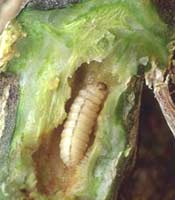 Squash vine borers are now active in plantings of winter squash, gourds, and pumpkins. The damage symptom is the sudden wilting of long runners or an entire plant. Infested vines usually die beyond the point of attack. Sawdust-like frass near the base of the plant is the best evidence of squash vine borer activity. Careful examination will uncover yellow-brown excrement pushed out through holes in the side of the stem at the point of wilting. If the stem is split open, one to several borers are usually present. The caterpillars reach a length of 1 inch and has a brown head and a cream-colored body. Winter squash, particularly 'Hubbard', are most susceptible to damage while 'Butternut' is somewhat resistant.
Squash vine borers are now active in plantings of winter squash, gourds, and pumpkins. The damage symptom is the sudden wilting of long runners or an entire plant. Infested vines usually die beyond the point of attack. Sawdust-like frass near the base of the plant is the best evidence of squash vine borer activity. Careful examination will uncover yellow-brown excrement pushed out through holes in the side of the stem at the point of wilting. If the stem is split open, one to several borers are usually present. The caterpillars reach a length of 1 inch and has a brown head and a cream-colored body. Winter squash, particularly 'Hubbard', are most susceptible to damage while 'Butternut' is somewhat resistant.
The key to squash vine borer management is controlling the borers before they enter the stem. Once inside the vine, insecticidal control is ineffective. Poor timing of sprays is the usual cause of inadequate control. Monitor plants weekly through August for initial signs of the borer's frass at entrance holes in the stems. Very early signs of larval feeding indicate that other eggs will be hatching soon. Use two to three insecticide applications, 7 days apart, to control newly hatching larvae and continue to monitor for additional activity. Sprays need to penetrate the canopy to cover the vines to be effective.
Home gardeners may have some success with deworming the vines. At the first signs of the sawdust-like frass, vines are slit lengthwise near where the damage is found and the borers removed. The stems should be immediately covered with earth. Sanitation is also important. After harvest is complete, vines should be removed from the garden and composted to prevent the remaining borers from completing larval development. Burying a few nodes along each vine will encourage rooting at these nodes. This will lessen the impact if squash vine borers girdle the base of the vine.
Squash vine borer pheromone traps have been used in several counties, but they have not been effective. County agents have noticed that they have seen squash vine borer activity even the traps are not capturing the moths. At this point, these pheromone traps should NOT be used to make squash vine borer management decisions.
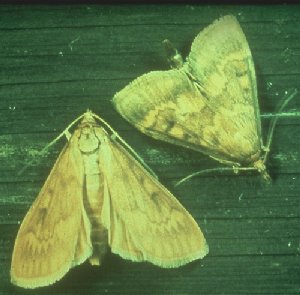 Second generation European corn borer moth flight has begun in the western portion of the state. Unlike the first generation, the second generation threatens pepper growers as well as corn producers. Pepper producers should initiate ECB management for their peppers.
Second generation European corn borer moth flight has begun in the western portion of the state. Unlike the first generation, the second generation threatens pepper growers as well as corn producers. Pepper producers should initiate ECB management for their peppers.
ECB larvae directly attack pepper fruit.
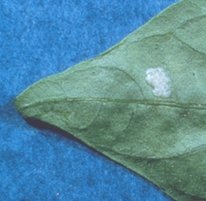
Eggs are laid on the undersides of leaves and are very difficult to scout accurately. Upon hatching from eggs, larvae will locate the fruit and begin to tunnel underneath the cap in 12 to 36 hours. This is the only period when the larvae can be controlled effectively. After they borer under the cap of the fruit, they cannot be controlled. Generally, insecticides need to be applied before egg hatch in order to be effective.
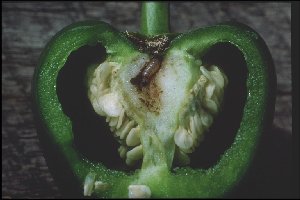
Growers in some counties are using ECB pheromone traps to monitor moth activity and determine the need for and timing of insecticide applications. Insecticide treatments should be timed to coinicide with peak moth activity. In most years, three sprays at 7 day intervals are needed during the period of adult activity.
 Recent rainfall and warm temperatures have afforded ideal conditions for mosquito development throughout Kentucky. There is no simple solution for combating this perennial summer pest.
Recent rainfall and warm temperatures have afforded ideal conditions for mosquito development throughout Kentucky. There is no simple solution for combating this perennial summer pest.
WHERE DO THEY COME FROM?
Mosquitoes need quiet, non-flowing water for their development. In Kentucky there are two primary groups of mosquitoes, Culex and Aedes. Mosquitoes of the Culex group generally lay their eggs on the surface of water in rain barrels, bird baths, tin cans, old tires, cisterns, roof gutters and any other container that holds water. Mosquitoes of the Aedes group lay their eggs at the base of vegetation bordering streams or in low-lying areas subject to flooding. Aedes mosquitoes can also deposit their eggs above the water line in old tires and other water-holding containers. These eggs hatch when inundated with rain water.
Mosquitoes develop rapidly, transforming into biting adults in as little as one week. A neglected bird bath or boat bottom allowed to accumulate water can produce hundreds of new mosquitoes each day.
WHAT CAN I DO ABOUT THEM?
Eliminate Breeding Sites - The best way to control mosquitoes is to find and eliminate their breeding sites. Eliminating large areas of standing water such as swamps or ditches may require community-wide effort. Nonetheless, homeowners can take steps to prevent mosquitoes from breeding on their property.
Controlling Adults - Some mosquitoes fly long distances. It may be necessary to supplement elimination of breeding sites with control tactics directed against migrating adults.
Exclusion - Mosquitoes can be kept out of homes by securely screening windows, doors and porches. The occasional mosquito found indoors can be eliminated with a fly swatter or aerosol-type insecticide labeled for flying insects.
Topically-Applied Repellents - Repellents will help prevent bites when spending time outdoors. Use mosquito repellents containing ingredients such as diethyl toluamide (DEET). In general, the higher the percentage of DEET in the ingredients, the longer the protection. Low -percentage formulations are available for use with young children. Non-DEET containing repellents (e.g. Avon Skin-So-Soft®, citronella) may provide some relief, but to a lesser degree and for a shorter duration. It is often desirable to apply insect repellent on outer clothing as well as the skin. Always read and follow directions on the container. Mosquito repellent should not be applied to the hands of young children, and treated skin should be washed with soap and water.
Vegetation Management - Adult mosquitoes prefer to rest in dense vegetation during the day. Consequently, homeowners should remove tall weeds and grass in their yard. To further reduce intolerable populations of adult mosquitoes around structures, insecticides can be applied to the lower limbs of shade trees, shrubs, and shaded areas adjacent to foundations. Lawn and garden formulations containing carbaryl, chlorpyrifos, malathion or synthetic pyrethroids (e.g., permethrin, cyfluthrin, cypermethrin, deltamethrin) are effective but of short duration.
Bug Zappers, Citronella Candles, Ultrasonics, etc. - Many consumer products claim to attract, repel or kill outdoor infestations of mosquitoes. Most of these devices do not work, or are only marginally effective. "Bug zappers" using ultraviolet light as an attractant are generally ineffective in reducing outdoor mosquito populations and their biting activity. Studies indicate that less that five percent of the mosquitoes killed by bug zappers are females -- the only ones that actually bite. The rest are non-biting, male mosquitoes and other harmless night flying insects.
Somewhat better results have been obtained with citronella candles. For maximum protection, use multiple candles positioned close, e.g., within a few feet, of where people are sitting. A single candle stationed at the outer edge of a large picnic blanket probably won't provide much protection.
Ultrasonic devices, mosquito-repellent plants and other "panaceas," routinely advertised in the mass media, are generally ineffective. If it sounds too good to be true, it probably is.
Last week in the diagnostic lab we saw several cases of Rhizoctonia stem rot on soybean and take-all on wheat. On tobacco we diagnosed bacterial blackleg, black shank, blue mold, soreshin, Fusarium wilt, Fusarium stem rot complex, stinkbug damage, nutritional problems, and virus infection (mostly TSWV).
On fruits we are seeing quite a bit of black rot of grape, and also diagnosed Phomopsis stem dieback on grape. Cedar-apple rust on apple was also noted. On vegetables we diagnosed scab on potato; stinkbug injury on sweet corn; Fusarium stem rot on canteloupe; Rhizoctonia stem rot on beans; buckeye rot, Pythium root rot, Fusarium stem rot, Fusarium wilt, Sclerotinia stem rot, bacterial canker and tomato spotted wilt virus on tomato.
On ornamentals we have seen Rhizoctonia root rot on daylily; anthracnose and leaf blotch (Cladosporium) on peony; powdery mildew on dogwood; Verticillium wilt on maple; necrotic ringspot, summer patch, brown patch and southern blight on turf. Note that the summer patch diagnosis was on Poa annua. We are not seeing this disease yet on Kentucky bluegrass; it typically shows up on KY bluegrass in August.

| UKREC-Princeton, KY, June 26 - July 2 | |
| European Corn Borer | 0 |
| Corn Earworm | 3 |
| True Armyworm | 47 |
| Southwestern Corn Borer | 20 |
| Fall Armyworm | 0 |
| Lexington, KY, June 29 - July 6 | |
| European Corn Borer | 0 |
| Corn Earworm | 39 |
| Diamondback Moth | 23 |
| Cabbage Looper | 0 |
| Beet Armyworm | 7 | True Armyworm | 0 |
Lee Townsend
Extension Entomologist